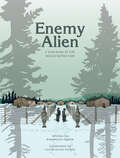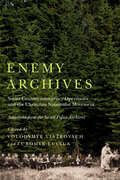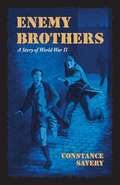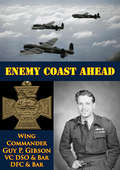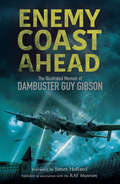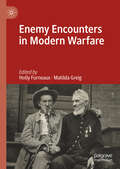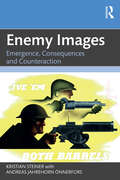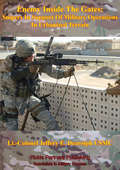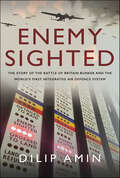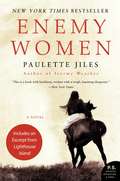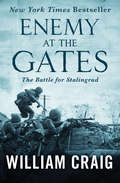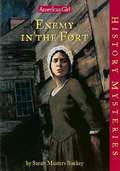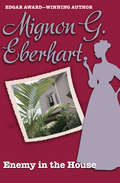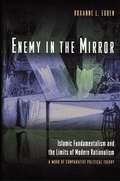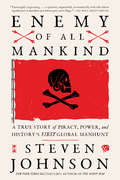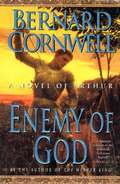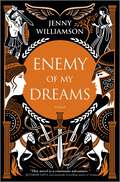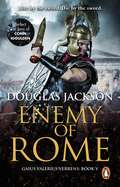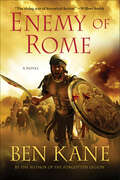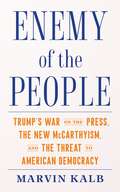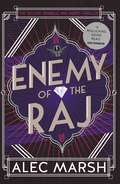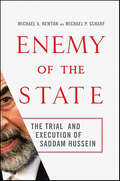- Table View
- List View
Enemy Alien: A True Story of Life Behind Barbed Wire
by Kassandra LuciukThis graphic history tells the story of Canada’s first national internment operations through the eyes of John Boychuk, an internee held in Kapuskasing from 1914 to 1917. The story is based on Boychuk’s actual memoir, which is the only comprehensive internee testimony in existence. The novel follows Boychuk from his arrest in Toronto to Kapuskasing, where he spends just over three years. It details the everyday struggle of the internees in the camp, including forced labour and exploitation, abuse from guards, malnutrition, and homesickness. It also documents moments of internee agency and resistance, such as work slowdowns and stoppages, hunger strikes, escape attempts, and riots. Little is known about the lives of the incarcerated once the paper trail stops, but Enemy Alien subsequently traces Boychuk’s parole, his search for work, his attempts to organize a union, and his ultimate settlement in Winnipeg. Boychuk’s reflections emphasize the much broader context in which internment takes place. This was not an isolated incident, but rather part and parcel of Canadian nation building and the directives of Canada’s settler colonial project.
Enemy Archives: Soviet Counterinsurgency Operations and the Ukrainian Nationalist Movement – Selections from the Secret Police Archives
by Volodymyr Viatrovych and Lubomyr LuciukAs Russia wages a twenty-first-century war against the very existence of a Ukrainian state and nation, reanimating Soviet-era propaganda that portrayed Ukrainians as Nazi collaborators and fascists, the experiences of the Ukrainian nationalist underground before, during, and after the Second World War gain new significance. While engaged in a decades-long struggle against the Ukrainian nationalist movement and the Ukrainian Insurgent Army (UPA), and lasting into the mid-1950s, Soviet counterinsurgency forces accumulated a comprehensive and extensive archive of documents captured from the Organization of Ukrainian Nationalists and the UPA. Volodymyr Viatrovych and Lubomyr Luciuk have curated and carefully annotated a selection of these documents in Enemy Archives, providing primary sources the Soviet authorities collected and deemed useful for better understanding their opponents and so securing their destruction, a campaign that ultimately failed.The documents seized from the insurgents and Soviet analyses of them shed light on a wide range of experiences in the underground: how the movement struggled to maintain discipline and morale, how it dealt with suspected informers, and how it resisted the ruthless Soviet state, laying the foundations for the continuing Ukrainian struggle against foreign domination.
Enemy Brothers: A Story of World War II
by Constance SaveryTHEY MADE A BARGAIN... They ate their meal by the fire. A little black cat came mewing and pawing for fish. "How many lives has a cat?" Dym asked, tickling her gently under her furry chin. Tony would not answer. "Nine," said Dym. "So have you. I mean that if you run away as often as nine times you won't get into trouble when you are caught. But the tenth time you are caught running away there will be a row, a really serious row. Understand?" Tony scowled. "You've lost three of your lives already. That leaves six, doesn't it?" There were disadvantages, Tony found, in a vow of eternal silence. For example, one had no power to protest violently against such a flagrant injustice such as this. He turned his eyes glowing with indignation on Dym. "You think that's not square, eh?" But Tony was wrathfully silent. Dym's grave young face broke suddenly into a smile. Though Tony would not have owned it for the world, he liked to see his captor smile. "Not going to be tricked into speaking to me, are you, Max? I'm afraid I did it on purpose-I wanted to see whether I could make you speak. Very good, then; we'll start from tonight. You have nine lives and no more. Is that fair warning?" Tony did not answer in words. In his heart he thought it was fair enough. Thus a private war declared between Tony and the inhabitants of the White Priory. British airman Dym Ingleford is convinced that young Max Eckermann is his brother, Anthony, who was kidnapped years before. Raised in the Nazi ideology, Tony has by chance tumbled into British hands. Dym has brought him back, at least temporarily, to the family he neither remembers nor will acknowledge as his own. As Tony uses his nine attempts to escape, his stubborn anger is whittled away by the patient kindness he finds at the White Priory. Then, just as he is resigning himself to the English family, a new chance suddenly opens for him to return home-to Germany! ENEMY BROTHERS, written in the early years of World War II before the United States joined the Allied forces, is a story of faith in the face of uncertainty. As the events and relationships develop, the reader is given an inside view of the confusion war brings and the triumph of the human spirit in the midst of it. Ages 10-up
Enemy Coast Ahead [Illustrated Edition]
by Wing Commander Guy P. Gibson VC DSO Bar Dfc BarIncludes the Aerial Warfare In Europe During World War II illustrations pack with over 200 maps, plans, and photos.THE classic account of the Royal Air Force Bomber Command during World War Two.This is probably the best-known memoir by a Bomber Command Officer. The author first saw active service with 83 Squadron in 1939 flying against German naval targets. After completing 39 missions he transferred to Fighter Command where he flew as a night-fighter pilot with 29 Squadron. In 1942, he was given command of 106 Squadron. Such was his success flying Lancasters that when 617 Squadron was formed for the specific task of attacking the Ruhr valley dams, the author was given command. Awarded the VC for the famous 'Dam Busters' raid, the author was commissioned to write this book, a task which he completed shortly before his death in 1944.-Print Ed. "A remarkable piece of descriptive writing. It records the night-to-night life of a bomber pilot with modesty, humour, and a rich understanding.it is extraordinarily adult work for such a young man."..."This is a magnificent story well and simply told by as great a warrior as these islands ever bred. It is also History." Marshal of the Royal Air Force, Sir Arthur Harris
Enemy Coast Ahead: The Illustrated Memoir of Dambuster Guy Gibson (Literature And History Of Aviation Ser.)
by Guy GibsonA definitive new edition of a classic, World War II memoir, complete with more than 100 photographs, and notes from leading historians. Guy Gibson was the leader of the famous Dambusters raid, and Enemy Coast Ahead is a vivid, honest account, widely regarded as one of the best books on the Second World War. It also provides an insider&’s perspective, setting down in clear detail the challenges that the RAF faced in the war against Germany&’s Luftwaffe. Tragically, Gibson died in September 1944, when his Mosquito crashed near Steenbergen in the Netherlands. He was aged just 26. This new book has been published to mark the 75th anniversary of his death and includes an introduction by James Holland, a historian and broadcaster. It includes notes by Dr Robert Owen, the Official Historian of the No. 617 Squadron Association, and many images that have never before been published. Published in association with the RAF Museum Inspired the 1955 film The Dam Busters, starring Richard Todd and Michael Redgrave
Enemy Encounters in Modern Warfare
by Holly Furneaux Matilda GreigWhile the 1914 Christmas truces have a mythological status in British culture, intimate interactions with the enemy are, this interdisciplinary edited collection shows, a staple of modern warfare. Spanning multiple conflicts around the world, from the nineteenth century to the present Russia/Ukraine war, the chapters consider how fellow-feeling with the enemy during war has been both fueled and limited by constellations of class, gender, nationality, race, religion, sexuality, and shared experience. Scrutinizing asymmetries of power in enemy encounters, the instability of divisions between allies and enemies, and the heterogeneity of experiences within one army or side, contributors to this book confront a central question: how far is thinking of the enemy as an ‘equal’ in some way a precondition for non-violent interactions with them in war? In some cases, the ease of fraternization and reciprocity between the lines raises questions about the necessity of a clear feeling of enmity for fighting to continue, while in others, exclusionary attitudes based on racial or colonial hierarchies or the criminality of irregular warfare result in extreme violence and differential valuations of enemy lives.
Enemy Images: Emergence, Consequences and Counteraction
by Kristian Steiner Andreas ÖnnerforsThis book offers a detailed understanding of ‘enemy images’, which are used in political rhetoric to dehumanize adversaries for various purposes, such as to legitimate violent conflicts.Applying theoretical models to a strong catalogue of historical and recent examples – from blood libel narratives in medieval manuscripts, to state-sponsored children’s board games in Nazi Germany and social media posts about the wars in Gaza and Ukraine – the book identifies how ‘enemy images’ have led to the development of dominant socio-political paradigms by providing justifications for and reinforcements of violent conflicts both within and between societies. In doing so, the work offers an up-to-date, accessible and authoritative overview of how to identify, analyse, and counteract energy images – which will be key to fostering social environments of reconciliation and peacebuilding for the future.This book will be of much interest to students and scholars of peace and conflict studies, International Relations, history, political sociology, and communication studies.
Enemy Inside The Gates: Snipers In Support Of Military Operations In Urbanized Terrain
by Lt.-Colonel Jeffery E. Dearolph USMCAs the world's urban areas continue to increase in size the possibility of U. S. forces conducting military operations in urbanized terrain also increases. However, the weapon systems the U. S. procures and employs obtain maximum effectiveness in open terrain. These weapons prove less capable in urban terrain since their standoff and precision advantages suffer degradation due to buildings and the fleeting nature of enemy personnel. U. S. weaponry also causes a large amount of collateral damage that may also result in civilian casualties, which proves politically unacceptable. Potential adversaries of the U. S. realize these limitations and present a target set that proves difficult to locate and engage. The target set the enemy uses in urban terrain consists of enemy combatants mixing with non-combatants, enemy snipers, and special purpose teams...Assets the U. S. possesses that can engage elements of the enemy's urban target set include U. S. Army and Marine Corps snipers. However, a determination on whether more snipers will effectively defeat the target set requires consideration...This monograph analyzes the contemporary operating environment to articulate the enemy's urban target set. Next, a review of current U. S. Army and Marine Corps sniping doctrine, organization and training establishes the foundation for presenting the sniper's capability to defeat the urban target set. In order to provide a balanced argument, other possible solutions to engaging and defeating the target set receive consideration...Research shows that the sniper company, organized at the division level, achieves the desired effect of increasing the density of sniper teams on the urban battlefield. The costs associated with the sniper company prove acceptable, as it requires minimal expenditure concerning personnel and equipment. The division sniper company will effectively counter the enemy's urban target set without causing non-combatant casualties.
Enemy Sighted': The Story of the Battle of Britain Bunker and the World’s First Integrated Air Defence System
by Dilip AminEnemy Sighted is the story of the world’s first integrated air defense system and how the coalition of Hurricanes and Spitfires, Fighter Command’s Operations Rooms and Sector Stations, Radar Stations, Observer Corps posts, anti-aircraft gun and searchlight batteries, and balloon barrages, stood resolutely in the way of Operation Seelöwe, Hitler’s plan for invading Britain in the Summer of 1940. Dilip Amin provides a fascinating insight into their development and eventual operationalization. The system provided a recognized air picture, giving everyone the same information at the same time, much like computers linked through the internet do today, except, in 1939 there was no computer and there was no internet! Fundamental to its telling is the 11 Group Operations Room, today referred to as the Battle of Britain Bunker, and the people who worked there, deep below RAF Uxbridge. It was after visiting the Bunker that Churchill first uttered the immortal words, ‘Never in the field of human conflict was so much owed by so many to so few’. Hidden underground, with its large map table and squadron display boards, and balloon and weather states, it is preserved as it was on 15 September 1940, the date celebrated as Battle of Britain Day. Dilip Amin describes how the Bunker operated, transporting the reader back to the time of the Battle of France and the final evacuation from Dunkirk. He guides the reader through the Battle of Britain, examining in detail, the events of 15 September, as seen by those in the Bunker and the combat reports of those flying the Hurricanes and Spitfires on that tumultuous day. Finally, the book provides an insight into how the Bunker operated to protect Britain during the Blitz; support the exploratory raid on Dieppe; shield the troops landing in Normandy; and defend against Hitler’s V1 and V2 Vengeance Weapons. Enemy Sighted provides a compelling insight into the remarkable history of a secret Operations Room, that was pivotal within a world leading air defense system, and without which, an Allied victory in the Second World War would have been far from certain.
Enemy Women: A Novel (P. S. Ser.)
by Paulette JilesFor the Colleys of southeastern Missouri, the War between the States is a plague that threatens devastation, despite the family's avowed neutrality. For eighteen-year-old Adair Colley, it is a nightmare that tears apart her family and forces her and her sisters to flee. The treachery of a fellow traveler, however, brings about her arrest, and she is caged with the criminal and deranged in a filthy women's prison. But young Adair finds that love can live even in a place of horror and despair. Her interrogator, a Union major, falls in love with her and vows to return for her when the fighting is over. Before he leaves for battle, he bestows upon her a precious gift: freedom. Now an escaped "enemy woman," Adair must make her harrowing way south buoyed by a promise . . . seeking a home and a family that may be nothing more than a memory.
Enemy at the Gates: The Battle for Stalingrad
by William CraigA classic work of World War II history that brings to vivid, dramatic life 1 of the bloodiest battles ever fought--and the beginning of the end for the Third Reich On August 5, 1942, giant pillars of dust rose over the Russian steppe, marking the advance of the 6th Army, an elite German combat unit dispatched by Hitler to capture the industrial city of Stalingrad and press on to the oil fields of Azerbaijan. The Germans were supremely confident; in 3 years, they had not suffered a single defeat.The Luftwaffe had already bombed the city into ruins. German soldiers hoped to complete their mission and be home in time for Christmas. The siege of Stalingrad lasted 5 months, 1 week, and 3 days. Nearly 2 million men and women died, and the 6th Army was completely destroyed. Considered by many historians to be the turning point of World War II in Europe, the Soviet Army's victory foreshadowed Hitler's downfall and the rise of a communist superpower. Bestselling author William Craig spent 5 years researching this epic clash of military titans, traveling to 3 continents in order to review documents and interview hundreds of survivors. Enemy at the Gates is the enthralling result: the definitive account of 1 of the most important battles in world history. The book was the inspiration for the 2001 film of the same name, starring Joseph Fiennes and Jude Law.
Enemy in Sight: The Royal Navy and Merchant Marine 1940-1942
by Stanley Reginald Harry RogersEnemy in Sight, first published in 1943, is an authoritative book on the activities of the British Royal Navy and Merchant Marine in the 1940-1942 period of World War Two. Author Stanley Rogers describes all the naval battles of that time, including the sinking of the formidable German battleship Bismarck, the history of the aircraft carrier Illustrious, the capture of a German U-Boat, the Dunkirk rescue flotilla, German E-Boats, stories of survival at sea, and much more, making Enemy in Sight a valuable historical resource and essential reading on the Allied navies and their crews in the Second World War. Included are 16 pages of photographs.
Enemy in the Fort (American Girl History Mysteries #13)
by Sarah Masters BuckeyIn 1954, with her own parents taken captive, twelve-year-old Rebecca must confront her fear and hatred of the Abenaki when a boy raised by members of that tribe is brought to the fort at Charlestown, New Hampshire, just before a series of thefts occurs.
Enemy in the House
by Mignon G. EberhartA tale of murder and suspense in Revolutionary-era South Carolina, from an Edgar Award–winning author: &“One of America&’s favorite writers&” (Mary Higgins Clark). Amity Mallam fears that her family&’s loyalty to King George III may result in their land being seized by George Washington&’s army—and in a last-ditch effort to save it, she marries her cousin Simon, a rebel. After the priest who officiated the ceremony is murdered—along with a lawyer who attended—she sets off to Jamaica to find her father, who had left her behind to run the plantation. But even more danger and turmoil awaits in the Caribbean, and Amity must untangle the truth and stave off the armies of two nations to protect them all. &“Intriguing.&” —Houston Chronicle &“One of the most thorough and ingenious plotters in the trade.&” —The New Yorker
Enemy in the Mirror: Islamic Fundamentalism and the Limits of Modern Rationalism: A Work of Comparative Political Theory
by Roxanne L. EubenA firm grasp of Islamic fundamentalism has often eluded Western political observers, many of whom view it in relation to social and economic upheaval or explain it away as an irrational reaction to modernity. Here Roxanne Euben makes new sense of this belief system by revealing it as a critique of and rebuttal to rationalist discourse and post-Enlightenment political theories. Euben draws on political, postmodernist, and critical theory, as well as Middle Eastern studies, Islamic thought, comparative politics, and anthropology, to situate Islamic fundamentalist thought within a transcultural theoretical context. In so doing, she illuminates an unexplored dimension of the Islamist movement and holds a mirror up to anxieties within contemporary Western political thought about the nature and limits of modern rationalism--anxieties common to Christian fundamentalists, postmodernists, conservatives, and communitarians. A comparison between Islamic fundamentalism and various Western critiques of rationalism yields formerly uncharted connections between Western and Islamic political thought, allowing the author to reclaim an understanding of political theory as inherently comparative. Her arguments bear on broad questions about the methods Westerners employ to understand movements and ideas that presuppose nonrational, transcendent truths. Euben finds that first, political theory can play a crucial role in understanding concrete political phenomena often considered beyond its jurisdiction; second, the study of such phenomena tests the scope of Western rationalist categories; and finally, that Western political theory can be enriched by exploring non-Western perspectives on fundamental debates about coexistence.
Enemy of All Mankind: A True Story of Piracy, Power, and History's First Global Manhunt
by Steven JohnsonThe New York Times bestselling author of Ghost Map and How We Got to Now returns with the story of a pirate who changed the world Most confrontations, viewed from the wide angle of history, are minor disputes, sparks that quickly die out. But every now and then, someone strikes a match that lights up the whole planet. Henry Every was the seventeenth century&’s most notorious pirate. The press published wildly popular—and wildly inaccurate—reports of his nefarious adventures. The British government offered enormous bounties for his capture, alive or (preferably) dead. But Steven Johnson argues that Every&’s most lasting legacy was his inadvertent triggering of a major shift in the global economy. Enemy of All Mankind focuses on one key event—the attack on an Indian treasure ship by Every and his crew—and its surprising repercussions across time and space. It&’s the gripping tale one of the most lucrative crimes in history, the first international manhunt, and the trial of the seventeenth century. Johnson uses the extraordinary story of Henry Every and his crimes to explore the emergence of the East India Company, the British Empire, and the modern global marketplace: a densely interconnected planet ruled by nations and corporations. How did this unlikely pirate and his notorious crime end up playing a key role in the birth of multinational capitalism? In the same mode as Johnson&’s classic non-fiction historical thriller The Ghost Map, Enemy of All Mankind deftly traces the path from a single struck match to a global conflagration.
Enemy of God: A Novel of Arthur (The Warlord Chronicles, No. #2)
by Bernard Cornwell[Back Cover] With The Winter King, the first volume of his magnificent Warlord Chronicles, Bernard Cornwell established himself as the storyteller who could reinvent the legend of King Arthur for our time. Now with Enemy of God, Cornwell's magical re-creation continues. Having defeated the last holdouts of civil war in southern Britain, Arthur has secured Mordred's throne. But he must still face raging conflicts between the old ways and the new, as well as foes more powerful and more dangerous-because they pose as friends. Brilliantly written and peopled with the familiar faces of legend along with new ones, Enemy of God is an immensely powerful continuation of a modern classic.
Enemy of My Dreams
by Jenny Williamson&“This novel is a cinematic adventure.&”—Jennifer Saint, internationally bestselling author of AriadneIn the last days of the Roman Empire, a desperate princess and a brutal Gothic warlord forge a dangerous alliance.Julia, only daughter of the emperor of Rome, lives a life of excess and freedom. Wine, philosophy, and scandal—she revels in hedonism. But when her father dies and her teenage brother takes the throne, he will stop at nothing to seize control of both the empire and his wayward sister. And now Alaric of the Visigoths, a ferocious warrior who has battled Rome for years, has come to the capital to bargain for his homeland.When Julia rebels against the marriage her brother has ordered her to accept, he responds by publicly punishing her lover in the Colosseum. Realizing how perilous her position is, Julia impulsively turns to Alaric—the empire&’s sworn enemy, and the one man who can make Rome tremble. Julia must find a way to make an ally of Alaric, a man she can&’t trust—a terrifying warlord with the power to bring both Julia and the empire to their knees—in an edgy, sexy cat-and-mouse game of attraction, defiance, and lust.
Enemy of Rome: (Gaius Valerius Verrens 5): Bravery and brutality at the heart of a Roman Empire in the throes of a bloody civil war (Gaius Valerius Verrens #5)
by Douglas JacksonA gripping, adrenalin-fuelled historical page-turner from bestselling author Douglas Jackson. Perfect for fans of Simon Scarrow and Ben Kane.Readers are loving Gaius Valerius Verrens! "Once you have started you will want to read every volume in this exciting series [set] during one of the most turbulent times in Roman history" - 5 STARS "Douglas Jackson undoubtedly holds the crown as king of his genre" - 5 STARS"It is another tough book to put down" - 5 STARS"An entertaining and compelling read that makes you feel as if you were there!" - 5 STARS*****************************************LIVE BY THE SWORD. DIE BY THE SWORD.Summer, AD 69: Rome and its empire are in turmoil. The emperor Otho is dead by his own hand and his rival, Aulus Vitellius, occupies the imperial throne. However, a new challenge has arisen in the East - the legions of Titus Flavius Vespasian have declared him their Emperor.In the dry heat of an August morning, Gaius Valerius Verrens prepares for his last day on Earth. Wrongly accused of deserting his legion on the field of Bedriacum, it seems he is destined to die a coward's death. Then the executioner's hand is stayed. Vitellius' enemies will spare his life if he pledges allegiance to Vespasian. Valerius - tired of the endless slaughter - agrees. And so he must battle his way south to Rome in order to persuade his friend Vitellius to stand down for the greater good. But this is civil war and this is Rome, and Valerius - his loyalties divided and branded an enemy of the people - is trapped in a maze of distrust, corruption, betrayal and blood-letting . . .Gaius Valerius Verrens's adventures continue in Scourge of Rome.
Enemy of Rome: A Novel (Hannibal #1)
by Ben KaneAs Rome rose to power in the 3rd century BCE there was only one real rival in the Mediterranean—Carthage. In the First Punic War, the Roman legions defeated and humiliated Carthage. Now Hannibal, a brilliant young Carthaginian general, is out for revenge. Caught up in the maelstrom are two young boys, Hanno, the son of a distinguished soldier and confidant of Hannibal, and Quintus, son of a Roman equestrian and landowner. A disastrous adventure will see Hanno sold into slavery and bought by Quintus's father. Although an unexpected friendship springs up between the two boys—and with Quintus's sister, Aurelia—the fortunes of the two warring empires will tear them apart. In Ben Ken's Hannibal: Enemy of Rome, they find themselves on opposite sides of the conflict and an alliance forged through slavery will be played out to its stunning conclusion in battle."A master of his discipline rightly hailed as one of the best historical novelists writing today." --Daily Express
Enemy of the People: Trump's War on the Press, the New McCarthyism, and the Threat to American Democracy
by Marvin Kalb[from inside flaps] ""The FAKE NEWS media is not my enemy, it is the enemy of the American People!" President Trump tweeted this declaration less than a month after his inauguration. Attacks on the media have been a hallmark of his presidential campaign and style of governance. This represents a dangerous and dramatic turning point. Twentieth-century dictators--Stalin, Hitler, and Mao--all denounced their critics, especially the press, as "enemies of the people." Their goal was to delegitimize the work of the press--effectively calling it "fake news," thereby creating confusion in the public's mind about what's real and what isn't, what can be trusted and what can't be. This also appears to be Trump's goal. In Enemy of the People, Marvin Kalb, an award-winning American journalist, writes with passion about his concerns for the future of American democracy. Can it withstand Trump's unrelenting attacks on the press? As Kalb shows, the press has been a bulwark of American democracy. He writes about Edward R. Murrow's courageous broadcasts that turned the cold light of reality on Senator Joseph McCarthy's "Red Scare" threats in the early 1950s. He also vividly reminds us of Bob Woodward and Carl Bernstein's reporting during the Watergate scandal, which led to President Richard Nixon's resignation. Without a fearless, robust press, democracy is in peril. Kalb's book is an eye-opening indictment of President Trump's efforts to debase and dehumanize the American media--and put the future of America's democracy in question."
Enemy of the Raj: The new Drabble and Harris thriller from the author of Rule Britannia
by Alec MarshThe second in the series of the Dabble and Harris thrillers! Set in the mid-twentieth century, this adventure series is perfect for fans of action-packed, historical fiction.'A rollicking good read' IAN RANKINIndia, 1937. Intrepid reporter Sir Percival Harris is hunting tigers with his friend, Professor Ernest Drabble. Harris soon bags a man-eater - but later finds himself caught up in a hunt of a different kind...Harris is due to interview the Maharaja of Bikaner, a friend to the Raj, for his London newspaper - and he and Drabble soon find themselves accompanied by a local journalist, Miss Heinz. But is the lady all she seems? And the Maharaja himself is proving elusive...Meanwhile, the movement for Indian independence is becoming stronger, and Drabble and Harris witness some of the conflict first-hand. But even more drama comes on arrival at Bikaner when the friends find themselves confined to their quarters... and embroiled in an assassination plot!Just who is the enemy in the Maharaja's palace? What is the connection to a mysterious man Drabble meets in Delhi? And what secret plans do the British colonial officers have up their sleeves?Praise for Alec Marsh's Drabble and Harris thrillers...'An immensely readable treat!' ALEXANDER MCCALL SMITH'Told with humour and flair, Enemy of the Raj is a highly enjoyable, riveting read'ABIR MUKHERJEE'A thoroughly engaging and enjoyable diversion'NEW STATESMAN on Enemy of the Raj 'Tremendous stuff! With the arrival of Alec Marsh's first Drabble and Harris thriller, John Buchan must be stirring uneasily in his grave'STANLEY JOHNSON
Enemy of the Raj: The new Drabble and Harris thriller from the author of Rule Britannia
by Alec MarshThe second in the series of the Dabble and Harris thrillers! Set in the mid-twentieth century, this adventure series is perfect for fans of action-packed, historical fiction.'A rollicking good read' IAN RANKINIndia, 1937. Intrepid reporter Sir Percival Harris is hunting tigers with his friend, Professor Ernest Drabble. Harris soon bags a man-eater - but later finds himself caught up in a hunt of a different kind...Harris is due to interview the Maharaja of Bikaner, a friend to the Raj, for his London newspaper - and he and Drabble soon find themselves accompanied by a local journalist, Miss Heinz. But is the lady all she seems? And the Maharaja himself is proving elusive...Meanwhile, the movement for Indian independence is becoming stronger, and Drabble and Harris witness some of the conflict first-hand. But even more drama comes on arrival at Bikaner when the friends find themselves confined to their quarters... and embroiled in an assassination plot!Just who is the enemy in the Maharaja's palace? What is the connection to a mysterious man Drabble meets in Delhi? And what secret plans do the British colonial officers have up their sleeves?Praise for Alec Marsh's Drabble and Harris thrillers...'An immensely readable treat!' ALEXANDER MCCALL SMITH'Told with humour and flair, Enemy of the Raj is a highly enjoyable, riveting read'ABIR MUKHERJEE'A thoroughly engaging and enjoyable diversion'NEW STATESMAN on Enemy of the Raj 'Tremendous stuff! With the arrival of Alec Marsh's first Drabble and Harris thriller, John Buchan must be stirring uneasily in his grave'STANLEY JOHNSON
Enemy of the State: The Trial and Execution of Saddam Hussein
by Michael P. Scharf Michael A. NewtonAt 12:21 p.m., on October 19, 2005, Saddam Hussein was escorted into the Courtroom of the Iraqi High Tribunal in Baghdad for one of the most important and chaotic trials in history. For a year, two American law professors had led an elite team of experts who prepared the judges and prosecutors for "the mother of all trials." Michael Scharf, a former State Department official who helped create the Yugoslavia Tribunal in 1993, and Michael Newton, then a professor at West Point, would confront such issues as whether the death penalty should apply, how to run a fair trial when political and military passions run so high, and which of Saddam's many crimes should be prosecuted.Newton was in Baghdad in December 2003 when the Tribunal was announced and Saddam was captured. In the following months, Scharf and Newton helped write the rules of the Tribunal, conducted a mock trial in (perhaps appropriately) Stratford-upon-Avon, England, and provided legal analysis on dozens of issues. Newton then returned to Baghdad several times during the trial and appeal. Now, from its two shapers, comes the fascinating inside story of the trial and execution of Saddam Hussein and the attempt to bring the rule of law to post-invasion Iraq.
Enemy or Friend? (The American Adventure #20)
by Norma Jean LutzFred Allerton is frustrated. Fred's father refuses to trust him with the very machines Fred built to make their furniture factory work faster. Then Papa hires Mr. Purlee to supervise Fred. It soon becomes clear to everyone but Papa that Mr. Purlee doesn't know what he's doing. Even worse in Fred's eyes is the fact that Mr. Purlee helps slave owners. Fred's problems follow him home when his sister Julia becomes close friends with Mr. Purlee's daughters and refuses to listen to Fred's warnings about them. When Mr. Purlee blames an explosion in the factory on Fred, and Papa believes the man, Fred leaves home to live with his cousin Tim. Will Papa and Fred settle their differences? And how can Fred's enemy possibly become his friend?
